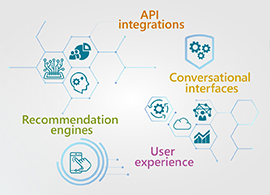
So, the previous blog on app modernization answered some of the basic questions on app modernization. Some of them were, what is app modernization, what are the reasons for modernization, and how is it done using technology. When it comes to the definition of app modernization it says, refactoring the legacy software to align it more closely to business needs. An important part of that definition is business needs. As per Gartner, the world-wide spending on applications will increase by 7.5 % and mount to $201 billion in 2019, this will be hugely driven by modernization and digital transformation.
So, clearly businesses are here to spend on modernization, and they will spend for the features that catch the interest of their customers. Let’s have a look on few of those features:
1) A seamless User Experience
Let’s consider enterprise software applications, they are designed to accommodate customization so that specific processes that companies put in place, can be perfectly represented and mirrored within the system. This leads to more complexity as the software will end up looking in a completely different way in every company it is implemented. This leads to
- Old looking icons and screens
- More time consumption in loading table grid structures, since the data keeps on increasing in such applications
- Absence of intuitive user experience
How can modernization be done here?
- Have metrics in place to measure the success of the overall user experience of the product so something like, time to load a grid should be 5 seconds and so on
- Improving existing UI patterns – So modernization can help here by redesigning the existing user workflows, adding insightful and predictive visualizations, and refactoring the manual activities in the UI layout
- Look if there are gaps in the technology stack – Updating the code of older UI frameworks is quite cumbersome. Adopting the new UI frameworks would not only help at code level, but also improve the functioning and response time of such applications.
2) Modernization using state-of-the-art features
Most of the legacy systems such as ERP, HCM, and Fintech deal with a lot of user interaction in the application. Such businesses do have their own dedicated loyal customers. But, one cannot ignore the fact that today personalization is more of a thing expected and desired in all major applications, and it may drive your loyal customers to other products as well. Implementing personalization not only keeps the existing customers satisfied, but it also helps increase business with new customers.
How can modernization be done here?
- API integrations– Integrations are a good way to connect your application to other software and have more offerings in your products. One such example is xAPI, that helps the learning systems to speak to each other in a manner that records and tracks all types of learning experience. This helps improve the LMS offerings.
- Conversational interfaces– When we are talking about personalization, chatbots and voice bots are the prime choices. Answering FAQs, making the application more understandable to the end user, giving notifications, etc., conversational interfaces are making life easier for the end users.
- Recommendation engines– Consider the old LMS systems, with the traditional course structure and layouts. Adding a recommendation engine that would suggest courses would help adding a personalized path for learning as per the user. This would enhance the user interaction with the system
3) Meeting regulatory compliance
More often legacy systems have high cost for implementing any compliance. Let’s consider GDPR, being non – compliant can lead to penalties. The implementation of pseudonymization strongly encouraged by the GDPR is much harder to achieve in legacy IT environments.
How can modernization be done here?
- Have a keen look at the implementation of collecting of data in the data sources for test and production data
- Instead of complete redesign from scratch, prefer giving more importance to step by step continuous upgradation
- Implement the highest security standards to avoid any financial penalties
- Watch out for worldwide compliances and make sure to refactor the legacy application to be compliant
There is no universal way to go about application modernization. It requires deep understanding of your application and its users. Redesigning an entire application is cumbersome, so a better approach would be to segment out the features you want to improve in the applications and then design the strategy around it. With a strategic planning and adoption of newer technology, modernizing your application shouldn’t be that difficult, what say?






